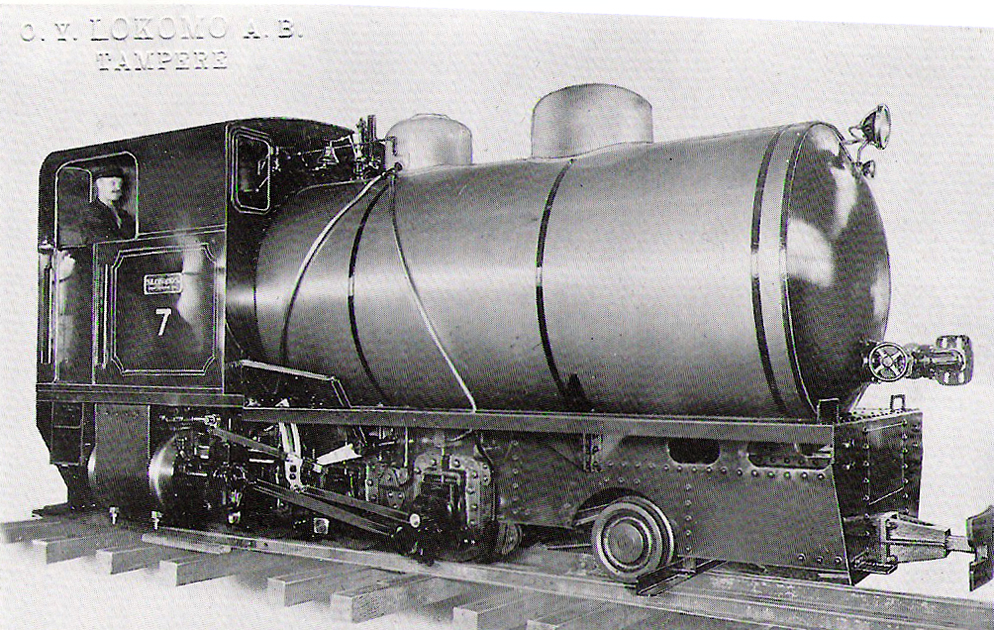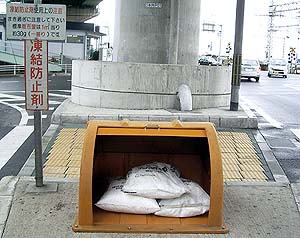|
Soda Locomotive
Soda locomotives were a variant of fireless locomotives, in which steam was raised in a boiler, expanded through cylinders in the usual way, and then condensed in a tank of caustic soda that surrounded the boiler. Dissolving water in caustic soda liberated heat, which generated more steam from the boiler, until the caustic soda became too dilute to release heat at a useful temperature. Technical description These closed-loop steam engines had no firebox. The boiler was jacketed by a container loaded with about 5 tons of caustic soda (sodium hydroxide). When water or steam came in contact with the caustic soda, it would generate heat—enough to actually run the boiler and generate more steam. Steam emanating from the boiler would be fed through pistons to propel the locomotive forward, and the exhaust steam from the pistons would be fed into the caustic soda to continue the cycle. These vehicles were virtually silent, because the steam was not released into the atmosphere ... [...More Info...] [...Related Items...] OR: [Wikipedia] [Google] [Baidu] |
Internals Of A Soda-powered Tramcar Of The Minneapolis, Lyndale And Minnetonka Railway Company
Internals usually refers to the internal parts of a machine, organism or other entity; or to the inner workings of a process. More specifically, internals may refer to: *the internal Organ (anatomy), organs *the gastrointestinal tract See also * Internal (other) {{disambiguation ... [...More Info...] [...Related Items...] OR: [Wikipedia] [Google] [Baidu] |
Fireless Locomotive
A fireless locomotive is a type of locomotive which uses reciprocating engines powered from a reservoir of compressed air or steam, which is filled at intervals from an external source. They offer advantages over conventional steam locomotives of lower cost per unit, cleanliness, and decreased risk from fire or boiler explosion; these are counterbalanced by the need for a source to refill the locomotive, and by the limited range afforded by the reservoir. They were desirable in situations where smoke from a firebox would be too noxious, or where there was risk of fire or explosion. Typical usage was in a mine, or a food or chemical factory. They were also used where a source of air or steam was readily available, and for moving loads within limited areas, such as a switch yard or within an industrial factory. They were eventually replaced for most uses by diesel and battery electric locomotives fitted with protective appliances; these are described as flame-proof locomotives. ... [...More Info...] [...Related Items...] OR: [Wikipedia] [Google] [Baidu] |
Caustic Soda
Sodium hydroxide, also known as lye and caustic soda, is an inorganic compound with the formula . It is a white solid ionic compound consisting of sodium cations and hydroxide anions . Sodium hydroxide is a highly corrosive base and alkali that decomposes lipids and proteins at ambient temperatures and at high concentrations may cause severe chemical burns. It is highly soluble in water, and readily absorbs moisture and carbon dioxide from the air. It forms a series of hydrates . The monohydrate crystallizes from water solutions between 12.3 and 61.8 °C. The commercially available "sodium hydroxide" is often this monohydrate, and published data may refer to it instead of the anhydrous compound. As one of the simplest hydroxides, sodium hydroxide is frequently used alongside neutral water and acidic hydrochloric acid to demonstrate the pH scale to chemistry students. Sodium hydroxide is used in many industries: in the making of wood pulp and paper, textiles, drinking w ... [...More Info...] [...Related Items...] OR: [Wikipedia] [Google] [Baidu] |
Sodium Carbonate
Sodium carbonate (also known as washing soda, soda ash, sal soda, and soda crystals) is the inorganic compound with the formula and its various hydrates. All forms are white, odourless, water-soluble salts that yield alkaline solutions in water. Historically, it was extracted from the ashes of plants grown in sodium-rich soils, and because the ashes of these sodium-rich plants were noticeably different from ashes of wood (once used to produce potash), sodium carbonate became known as "soda ash". It is produced in large quantities from sodium chloride and limestone by the Solvay process, as well as by carbonating sodium hydroxide which is made using the chloralkali process. Hydrates Sodium carbonate is obtained as three hydrates and as the anhydrous salt: * sodium carbonate decahydrate ( natron), Na2CO3·10H2O, which readily effloresces to form the monohydrate. * sodium carbonate heptahydrate (not known in mineral form), Na2CO3·7H2O. * sodium carbonate monohydrate ( thermonatr ... [...More Info...] [...Related Items...] OR: [Wikipedia] [Google] [Baidu] |
Calcium Chloride
Calcium chloride is an inorganic compound, a Salt (chemistry), salt with the chemical formula . It is a white crystalline solid at room temperature, and it is highly soluble in water. It can be created by neutralising hydrochloric acid with calcium hydroxide. Calcium chloride is commonly encountered as a Water of crystallization, hydrated solid with generic formula , where ''n'' = 0, 1, 2, 4, and 6. These compounds are mainly used for de-icing and dust control. Because the anhydrous salt is Hygroscopic, hygroscopic and deliquescent, it is used as a desiccant.Robert Kemp, Suzanne E. Keegan "Calcium Chloride" in Ullmann's Encyclopedia of Industrial Chemistry 2000, Wiley-VCH, Weinheim. History Calcium chloride was apparently discovered in the 15th century but wasn't studied properly until the 18th century. It was historically called "fixed Salammoniac, sal ammoniac" () because it was synthesized during the distillation of ammonium chloride with lime and was nonvolatile (while ... [...More Info...] [...Related Items...] OR: [Wikipedia] [Google] [Baidu] |
Loftus Perkins
Loftus Perkins (8 May 1834 – 27 April 1891) was an English engineer, particularly involved in developing the practical technologies of central heating and refrigeration. Life Perkins was born in London, the son of Angier March Perkins and was likely apprenticed to his father. His grandfather, Jacob Perkins, had arrived in England from New England and the family still had many contacts in the U.S. so, in 1853-4 Loftus worked in America. After further work for his father, and in Hamburg and Berlin before establishing the partnership of A. M. Perkins & Son with his father.McConnell (2004) He devoted his energies to heating and refrigeration and combined great imagination with practical engineering instincts. He also contributed to the development of the steam engine. Among his innovations were: *The "Polly Perkins" - mobile steam ovens for the British Army; *Steam ovens for use in bakeries; *High-pressure steam tractors; *''The Anthracite'' - a 70-ton yacht powered by high-press ... [...More Info...] [...Related Items...] OR: [Wikipedia] [Google] [Baidu] |
Baldwin Locomotive Works
The Baldwin Locomotive Works (BLW) was an American manufacturer of railway locomotives from 1825 to 1951. Originally located in Philadelphia, Pennsylvania, it moved to nearby Eddystone, Pennsylvania, Eddystone in the early 20th century. The company was for decades the world's largest producer of steam locomotives, but struggled to compete when demand switched to diesel locomotives. Baldwin produced the last of its 70,000-plus locomotives in 1951, before merging with the Lima Locomotive Works, Lima-Hamilton Corporation on September 11, 1951, to form the Baldwin-Lima-Hamilton Corporation. The company has no relation to the E.M. Baldwin and Sons of New South Wales, Australia, a builder of small diesel locomotives for sugar cane railroads. History: 19th century Beginning Matthias W. Baldwin, the founder, was a jeweler and whitesmith, who, in 1825, formed a partnership with machinist David H. Mason, and began making bookbinders' tools and cylinders for calico printing. Baldwin t ... [...More Info...] [...Related Items...] OR: [Wikipedia] [Google] [Baidu] |
Steam Vehicles
Steam is water vapor, often mixed with air or an aerosol of liquid water droplets. This may occur due to evaporation or due to boiling, where heat is applied until water reaches the enthalpy of vaporization. Saturated or superheated steam is invisible; however, wet steam, a visible mist or aerosol of water droplets, is often referred to as "steam". When liquid water becomes steam, it increases in volume by 1,700 times at standard temperature and pressure; this change in volume can be converted into mechanical work by steam engines such as reciprocating piston type engines and steam turbines, which are a sub-group of steam engines. Piston type steam engines played a central role in the Industrial Revolution and modern steam turbines are used to generate more than 80% of the world's electricity. If liquid water comes in contact with a very hot surface or depressurizes quickly below its vapour pressure, it can create a steam explosion. Types of steam and conversions Steam is trad ... [...More Info...] [...Related Items...] OR: [Wikipedia] [Google] [Baidu] |







